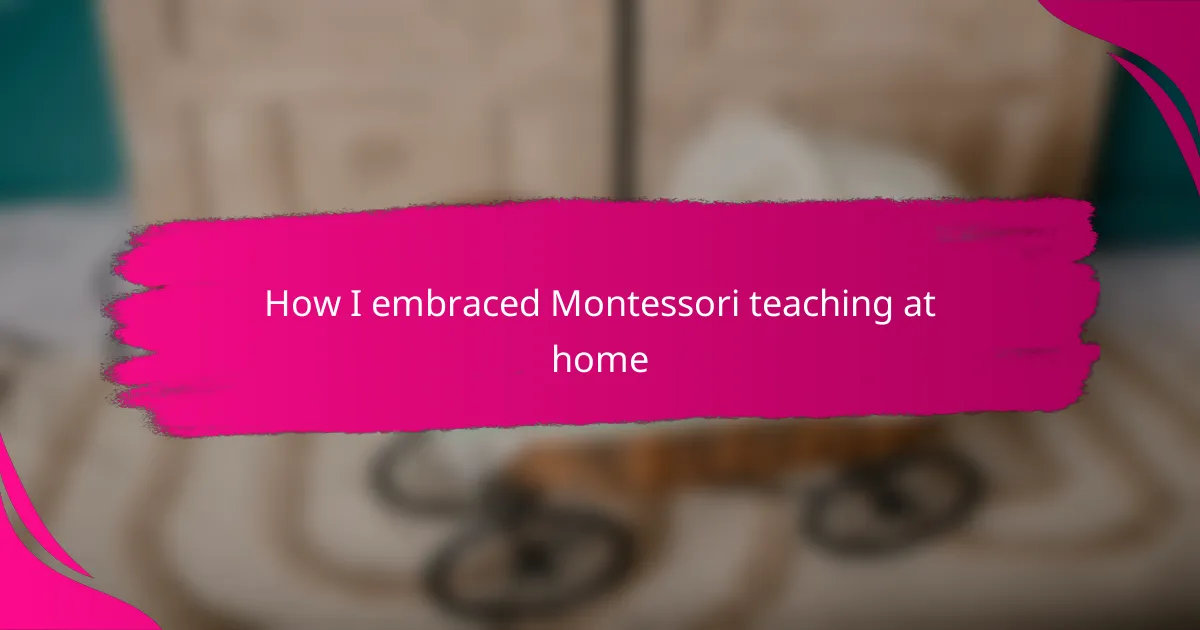Key takeaways
- Montessori teaching fosters independence and hands-on learning, allowing children to explore concepts at their own pace.
- Creating a Montessori environment with accessible materials encourages responsibility and concentration in children.
- Regular, simple activities that incorporate routine and choice enhance children’s control and confidence in their learning.
- Consistency and observation are vital in Montessori practice, promoting a nurturing and engaging learning experience.

What is Montessori Teaching
Montessori teaching is all about respecting a child’s natural curiosity and allowing them to explore at their own pace. I remember feeling amazed the first time I saw my daughter fully absorbed in a simple wooden puzzle, completely in control of her learning experience. Isn’t it incredible how this approach trusts kids to lead their own education rather than forcing them through rigid lessons?
What really stands out to me is how Montessori focuses on hands-on learning and fostering independence. Instead of sitting passively, children actively discover concepts through tangible materials that make abstract ideas concrete. This method feels so different from traditional teaching—it’s like giving kids the freedom to build their understanding piece by piece.
At its core, Montessori teaching honors the child as an individual with unique interests and rhythms. Looking back, I realize how this approach helped nurture my child’s confidence and joy in learning. Have you ever noticed how much more engaged a child becomes when they feel empowered rather than directed? That small but powerful shift changed everything for us.

Benefits of Montessori at Home
One of the biggest benefits I found with Montessori at home is how it naturally builds my child’s independence. Watching my little one choose activities and complete tasks on their own gave me a deep sense of pride. Isn’t it amazing when children start to trust themselves instead of relying entirely on adults?
Another thing that struck me was how this approach nurtures concentration. When my daughter gets involved in a hands-on activity, time seems to disappear for her. That kind of deep focus isn’t easy to spark with traditional toys or worksheets.
Also, Montessori at home creates a calm and orderly environment that really supports learning. Having materials within reach and everything in its place feels like a quiet invitation to explore. I noticed how less stressful mornings became when my child knew exactly what to do next.

Setting Up a Montessori Environment
Creating a Montessori environment at home was like giving my child a special invitation to learn on her own terms. I made sure every shelf was low enough for her to reach independently, filling it with simple, natural materials that sparked her curiosity without overwhelming her. Have you ever seen a child’s face light up when they discover something they can handle by themselves? That moment of pride is priceless.
I also realized that order matters just as much as freedom. By keeping the space neat and everything in its place, my daughter knew where to find what she needed and, equally important, where to return it. This small routine fostered her sense of responsibility and respect for her learning space—did you know kids often mirror how adults treat their surroundings?
Finally, I tailored the environment to suit my child’s interests, rotating materials to keep things fresh and inviting. It wasn’t about cluttering the room but about offering choices that felt meaningful to her at the moment. Doesn’t a thoughtfully arranged space make learning feel less like a chore and more like an exciting journey? For us, it definitely did.

Essential Montessori Materials
Montessori materials became the heart of our learning nook. I remember how a simple set of wooden blocks transformed into building castles and forming letters, giving my child both freedom and focus. Isn’t it amazing how the right materials can turn abstract ideas into something tangible and exciting?
Choosing materials felt like selecting tools for an adventure—a sensory bin, counting beads, or a color-matching tray each invited exploration in its own unique way. I found that natural materials like wood and cotton added warmth and texture, making activities feel inviting rather than overwhelming. Have you noticed how children often gravitate toward objects they can touch and manipulate?
What surprised me most was how these simple, purposeful materials encouraged persistence. When my daughter struggled with a puzzle, she kept trying without frustration because the pieces were designed for success through repetition. That gentle challenge—not easy or too hard—seemed just right to keep her curiosity alive and thriving.

Daily Montessori Activities for Kids
Every day, I set out a few simple Montessori activities that my daughter can choose from freely—whether it’s pouring water between cups or threading beads onto a string. Watching her carefully focus on these tasks without interruption always reminds me how powerful hands-on learning can be. Don’t you think there’s something magical about a child fully immersed in their own discovery?
I noticed that having a predictable routine makes these activities even more effective. Each morning, my daughter knows exactly where to find the materials and what she can do next, which gives her a wonderful sense of control and confidence. It’s amazing how a little structure doesn’t stifle creativity but actually supports it.
One day, I observed her carefully sweeping up tiny crumbs after a snack, just like she does after a craft project. This simple responsibility became one of our daily Montessori activities, showing me how small, practical life skills weave naturally into her learning and independence. Have you experienced how these everyday moments truly bring Montessori philosophy to life?

Challenges Faced and Solutions
At first, I struggled with finding the right balance between guiding my daughter and letting her lead. It was tempting to step in and “fix” when she got frustrated, but I learned to hold back and trust her process. Have you ever felt torn between helping and stepping back? Over time, I saw how this patience built her resilience and problem-solving skills.
Another challenge was setting up a dedicated learning space in a busy household. It took some creativity and compromise to keep materials accessible yet organized. I found that involving my daughter in tidying up made a huge difference—not just for order, but for teaching her responsibility too. Doesn’t it feel great when kids take ownership of their space?
Lastly, I faced moments of doubt wondering if Montessori at home was enough without formal lessons. But then I noticed how deeply engaged she became with simple activities, and it reassured me that this approach really meets children where they are. Have you been surprised by how powerful everyday moments can be in shaping a child’s education?

Tips for Consistent Montessori Practice
Consistency became my best friend in practicing Montessori daily. I made it a habit to observe my daughter quietly before offering help—this little pause helped me understand what she truly needed without interrupting her flow. Have you ever noticed how stepping back sometimes feels harder than jumping in, but actually supports deeper learning?
I also found that keeping the environment predictable yet flexible was key. When materials had a “home” and my daughter knew the routine, she felt safe to explore confidently, but I made sure to refresh activities regularly to keep her curiosity alive. This balance between structure and novelty made all the difference in our day-to-day practice.
Finally, I reminded myself that Montessori at home isn’t about perfection—it’s about gentle consistency. Even on busy or tiring days, offering simple, hands-on experiences without pressure kept the momentum going. Doesn’t it feel reassuring to know that small, steady efforts create a meaningful learning rhythm? For us, that mindset made all the difference.
